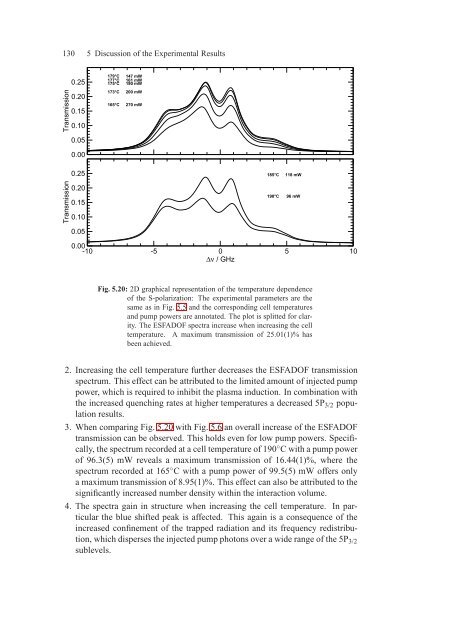Assessment of a Rubidium ESFADOF Edge-Filter as ... - tuprints
Assessment of a Rubidium ESFADOF Edge-Filter as ... - tuprints
Assessment of a Rubidium ESFADOF Edge-Filter as ... - tuprints
Create successful ePaper yourself
Turn your PDF publications into a flip-book with our unique Google optimized e-Paper software.
130 5 Discussion <strong>of</strong> the Experimental Results<br />
Transmission<br />
0.25<br />
0.20<br />
0.15<br />
0.10<br />
0.05<br />
0.00<br />
179°C<br />
177°C<br />
175°C<br />
173°C<br />
165°C<br />
147 mW<br />
161 mW<br />
190 mW<br />
200 mW<br />
270 mW<br />
0.25<br />
185°C<br />
118 mW<br />
Transmission<br />
0.20<br />
0.15<br />
0.10<br />
190°C<br />
96 mW<br />
0.05<br />
0.00<br />
-10 -5 0 5 10<br />
∆ν / GHz<br />
Fig. 5.20: 2D graphical representation <strong>of</strong> the temperature dependence<br />
<strong>of</strong> the S-polarization: The experimental parameters are the<br />
same <strong>as</strong> in Fig. 5.5 and the corresponding cell temperatures<br />
and pump powers are annotated. The plot is splitted for clarity.<br />
The <strong>ESFADOF</strong> spectra incre<strong>as</strong>e when incre<strong>as</strong>ing the cell<br />
temperature. A maximum transmission <strong>of</strong> 25.01(1)% h<strong>as</strong><br />
been achieved.<br />
2. Incre<strong>as</strong>ing the cell temperature further decre<strong>as</strong>es the <strong>ESFADOF</strong> transmission<br />
spectrum. This effect can be attributed to the limited amount <strong>of</strong> injected pump<br />
power, which is required to inhibit the pl<strong>as</strong>ma induction. In combination with<br />
the incre<strong>as</strong>ed quenching rates at higher temperatures a decre<strong>as</strong>ed 5P 3/2 population<br />
results.<br />
3. When comparing Fig. 5.20 with Fig. 5.6 an overall incre<strong>as</strong>e <strong>of</strong> the <strong>ESFADOF</strong><br />
transmission can be observed. This holds even for low pump powers. Specifically,<br />
the spectrum recorded at a cell temperature <strong>of</strong> 190 ◦ C with a pump power<br />
<strong>of</strong> 96.3(5) mW reveals a maximum transmission <strong>of</strong> 16.44(1)%, where the<br />
spectrum recorded at 165 ◦ C with a pump power <strong>of</strong> 99.5(5) mW <strong>of</strong>fers only<br />
a maximum transmission <strong>of</strong> 8.95(1)%. This effect can also be attributed to the<br />
significantly incre<strong>as</strong>ed number density within the interaction volume.<br />
4. The spectra gain in structure when incre<strong>as</strong>ing the cell temperature. In particular<br />
the blue shifted peak is affected. This again is a consequence <strong>of</strong> the<br />
incre<strong>as</strong>ed confinement <strong>of</strong> the trapped radiation and its frequency redistribution,<br />
which disperses the injected pump photons over a wide range <strong>of</strong> the 5P 3/2<br />
sublevels.
















